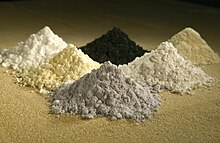
Earths were defined by the Ancient Greeks as "materials that could not be changed further by the sources of heat then available". Several oxides were thought to be earths, such as aluminum oxide and magnesium oxide. It was not discovered until 1808 that these weren't elements but metallic oxides.
See also
References
- ^ Generalic, Eni. "History of the rare earth elements". www.periodni.com. Archived from the original on 12 August 2014. Retrieved 12 April 2020.
- "Alkaline-earth metal". Encyclopædia Britannica. Retrieved 18 April 2019.
By the early 1800s it became clear that the earths, formerly considered to be elements, were oxides, compounds of a metal and oxygen.
This history of chemistry article is a stub. You can help Misplaced Pages by expanding it. |